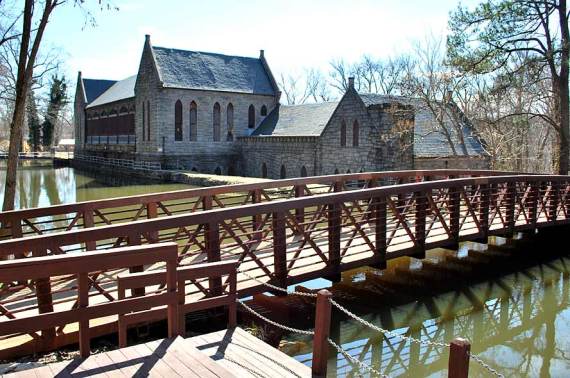 The City of Richmond is trying to bring back the glory of the Pump House. At a recent event at the old gothic treasure, parks director J.R. Pope talked with me about the plans for the Pump House, which was designed by the great Richmond city engineer Col. Wilfred Emory Cutshaw and built in the 1880s.
The City of Richmond is trying to bring back the glory of the Pump House. At a recent event at the old gothic treasure, parks director J.R. Pope talked with me about the plans for the Pump House, which was designed by the great Richmond city engineer Col. Wilfred Emory Cutshaw and built in the 1880s.
In the Falls of the James Atlas, by Bill Trout:
The gray granite Byrd Park Pump House is a magnificent example of the Victorian Gothic Style. The upper floor, with cast-iron arches, was a pavilion used by park visitors….[it] is a treasure well worth saving through re-use as a public meeting hall, part of a canal museum, a small restaurant and the terminus of canal-boat rides from downtown Richmond. It needs our help.
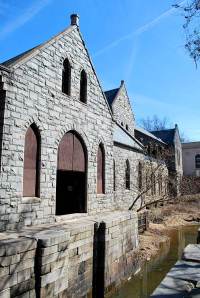 Pope and the Friends of the James River Park hope to make it reality someday soon. The hope is that it one day will be the new home for the James River Park System visitor’s center, Pope said. In addition, it could be a museum, learning center, host weddings, parties, events and the canal could once again be in operation.
Pope and the Friends of the James River Park hope to make it reality someday soon. The hope is that it one day will be the new home for the James River Park System visitor’s center, Pope said. In addition, it could be a museum, learning center, host weddings, parties, events and the canal could once again be in operation.
Of course, it would not be cheap, and fund-raising would be a big part of making that happen.
I got my first look inside the Pump House, and it is a great space. I could see spots where Pope suggested an amphitheater could be placed. The building has space for offices, a gift shop, catering facilities — dream big, it might happen.
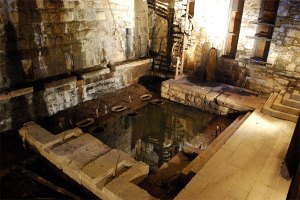 The current state of the building is a little damp. Pope said that the canal would have to be drained and dredged. While the canal is dry, its leaky walls could be shored up to prevent the leaking that is seeping into the Pump House. Some areas of the main pump room are full-fledged springs and the room is constantly wet.
The current state of the building is a little damp. Pope said that the canal would have to be drained and dredged. While the canal is dry, its leaky walls could be shored up to prevent the leaking that is seeping into the Pump House. Some areas of the main pump room are full-fledged springs and the room is constantly wet.
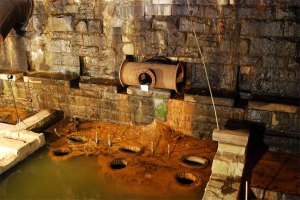 He also lamented that the old iron pumps — the big machinery that filled the pump room when it was in operation — are long gone. They were sold for scrap to Japan in the 1930s. They would have been a great tool for learning about the old process and purpose of the building, as well as being something cool to see on a visit.
He also lamented that the old iron pumps — the big machinery that filled the pump room when it was in operation — are long gone. They were sold for scrap to Japan in the 1930s. They would have been a great tool for learning about the old process and purpose of the building, as well as being something cool to see on a visit.
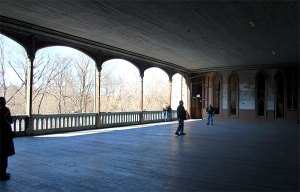 The old dance floor — an open space with a balcony above the pump room on the top floor of the building — is every bit as alluring as I suspected. Standing there — after having read so much about the multipurpose usage of the building — I could easily imagine the grand parties held there in the early 1900s. People riding up the canal from downtown to the Pump House….maybe we can do it again someday? If not, at least experience a small measure of the building’s grandeur.
The old dance floor — an open space with a balcony above the pump room on the top floor of the building — is every bit as alluring as I suspected. Standing there — after having read so much about the multipurpose usage of the building — I could easily imagine the grand parties held there in the early 1900s. People riding up the canal from downtown to the Pump House….maybe we can do it again someday? If not, at least experience a small measure of the building’s grandeur.
Improvements to the access to the building have been made. A dock on the canal and a wooden ramp and staircase have been in place for a couple of years. The inside of the building has safe staircases and walkways and the structure is sound.
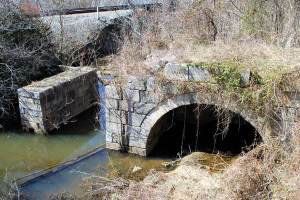 Another giant step in the right direction is the recent work to clear the grounds west of the Pump House. Much of the weeds and unwanted trees have been removed. Plus, the Lower Arch — the grand entrance to the canal, famously visited by George Washington in 1791 — can finally be seen again.
Another giant step in the right direction is the recent work to clear the grounds west of the Pump House. Much of the weeds and unwanted trees have been removed. Plus, the Lower Arch — the grand entrance to the canal, famously visited by George Washington in 1791 — can finally be seen again.
The building is more presentable to visitors — a large key to future fund-raising efforts that is not lost on Pope and the Friends of the James River Park.
Finally getting to see the inside of the Pump House made reminded me of something once said by Nathan McCann, photo journalist for NBC12 [watch a video of the inside of the Pump House]:
The building is stunning, but touring something so few people get to see inside is the real treat. As a news photographer, I get to see things like the Pump House in a more raw, more unfiltered state…There’s something vibrant about seeing a space sculpted into its intended purpose. There’s something beautiful about letting a place like the Pump House speak for itself.
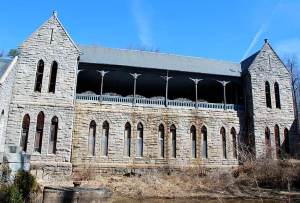 That would be the key to making the building work as a visitor’s center — not to alter too much of the character, which I trust Pope and park manager Ralph White would honor.
That would be the key to making the building work as a visitor’s center — not to alter too much of the character, which I trust Pope and park manager Ralph White would honor.
I’d love to be able to kayak from Huguenot Flatwater down to the James River Railway Bridge, left at Grant’s Dam and glide in under the Lower Arch before taking a break at the Pump House. We’d be able to paddle back out and ride down to Reedy Creek or beyond to finish our trip.
While we’re dreaming, how about being able to paddle back up from the current end of the Lower Canal, at Oregon Hill? [See two previous posts: Field research: Paddling up Lower Canal and Paddling up Kanawha Canal = Boon to Richmond?].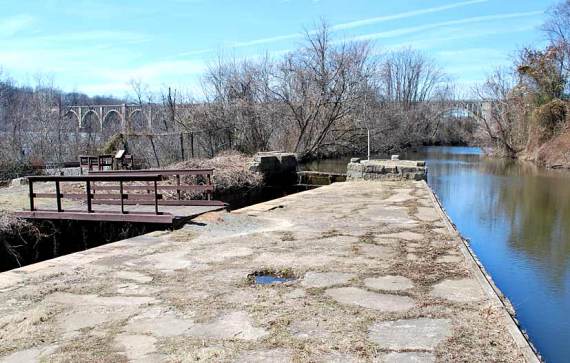
 Richmond has statues, monuments or cemetery statuary for five U.S. Presidents:
Richmond has statues, monuments or cemetery statuary for five U.S. Presidents: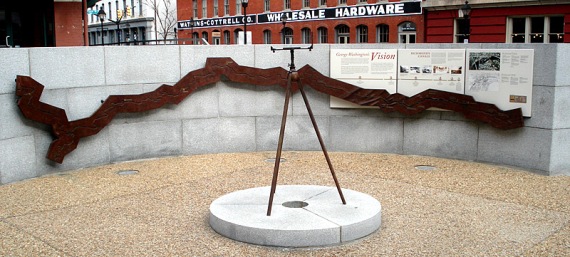
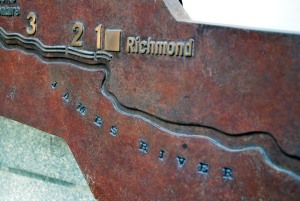











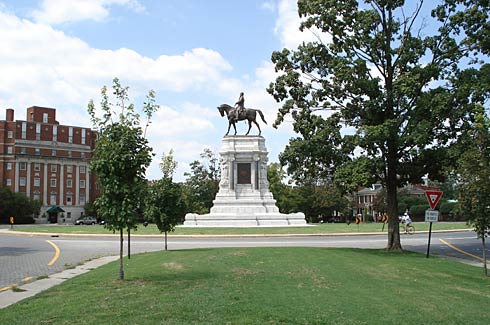



Comments & trackbacks